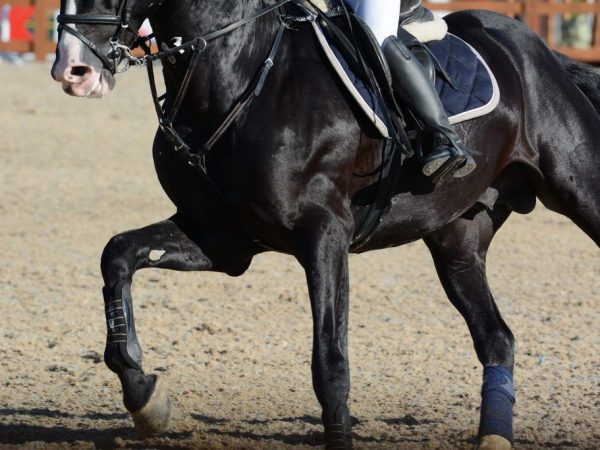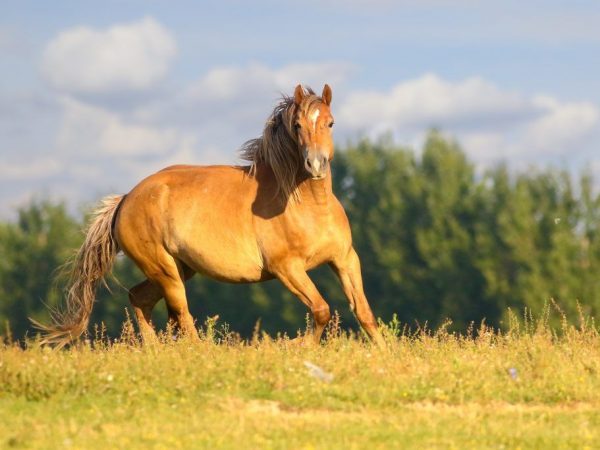Types of horse gallop
Horse riding requires certain skills and abilities. Horse gallop is the fastest way to move a strong and graceful animal.

Horse gallop
There are several types of gallops by which horses move in nature, as well as a couple of types of this gait that people invented. Artificial running is difficult to perform and is taught in riding schools. Let's consider how one type of gallop differs from another, and what is the technique of performing this gait.
Features of the
Horses galloping can cover significant distances in a short time. It is this type of gait that can be seen at the races, where animals compete in speed. Horses at a gallop develop a speed of up to 70 km / h, but this is the maximum possible speed of movement of the horses. As for the average indicators, they are 50-55 km / h, which is not bad at all for animals.

Features of the fastest gait
Moving at a gallop, horses spend a lot of energy, which is the second feature of this gait. Accordingly, animals cannot jump in this way for a long time: this can lead not only to health problems, but also to the death of pets. Under natural conditions, horses rarely use gallop. This step is needed in order for the horse to be able to escape from natural enemies.
There is also the so-called high-spirited gallop, which assumes that the horse moves at maximum speed. This type of horse gallop is called a quarry.
During the gallop movement, the animal sometimes takes a step, the length of which is 2-3 times longer than the body length.
Types and technique of performing a gallop
Let's start with a description of the gait technique. A horse gallop is a run. And running differs from walking in that there is an unsupported phase, which assumes that all the legs of the animal are in the air. Conventionally, there are 3 phases in canter running. During the first, the horse puts its hind foot on the ground, it gets the first support. The second phase begins with placing the second hind leg and one front leg on the ground. At the same time, the horse puts a foot on the ground, which is located diagonally (right hind and left front, for example). During the third phase, the horse lifts one hind leg into the air (the one that he put on the ground during the first phase), and puts the second front leg on the ground. This is followed by an unsupported phase of movement, during which all legs are in the air.
If you listen to the sound made by horses while running, you can hear 3 separate hoof strikes on the ground, corresponding to 3 phases of running.

Varieties of horse gallop
Technically, the canter as a form of gait is the most difficult. In this case, the load on the legs is distributed unevenly. Depending on the distribution of the load, there are 2 types of horse gallop:
- right-sided (the horse starts moving with the right leg);
- left-sided (the horse starts moving with the left leg).
The leading leg is considered to be the front leg on which the horse rests before entering the phase of unsupported movement. The same leg carries more load than all the others. As a rule, horses run in a left-sided gallop during races. This is due to the fact that at the races the horses run in a circle, and first the right hind leg is on the ground, then the right front leg, which are closer to the center of the circle. Turns to the right at such a canter are more convenient to perform. If the horse is moving in a left-sided gallop, turning is uncomfortable, and the step is less stable. In this case, experts say that the horse rides with a counterhalop.
While driving, keep in mind that a left-sided canter is more convenient for turning to the left. It is easier for horses to turn right during a right-handed gallop.
Gallop classification according to movement speed
There are several types of gallop, depending on the speed of movement of the horse. Let's consider each of them separately.
- The cuff gallop assumes that the horse's speed does not exceed 25-30 km / h. This type of gallop is also called short. It is used if you need to cover a distance with a large number of turns located close to each other.
- Most often, during training of horses, a field gallop is used. In this case, the horses develop an average speed, and the rider learns to stay in the saddle. The field gallop is rarely used by jockeys at horse races.
- The fastest type of running is called the quarry. Here the horse is working to the limit of its capabilities. Before starting a horse in a quarry, you should teach him to move correctly in a cuff and field gallop.
Some experts distinguish another type of canter - canter. This is the so-called shortened field gallop.
This type of gait is best characterized by the world record set in the USA. There the horse covered a distance of 1 km in just 54 seconds.
Types of artificial gallops
If the above types of gallop do not need to be taught to the horse, then there are gaits invented by people, which the horses master exclusively in the process of training. And learning to do them correctly is not easy.
All artificial types of gallops are used in those types of competitions where it is necessary to show the beauty of movement, and not speed.
Allure on 3 legs
The first type of artificial gait is called the 3-legged gallop. As the name suggests, one leg of the horse is not used during the gait. Her horse pulls forward. Generally, during a 3-legged gallop, the right foreleg does not touch the ground.
This type of gallop, unlike the usual one, is not a jogging. There is no phase of unsupported movement here.
In competitions, the judges are very strict about this step. The leg must be constantly stretched and raised to a certain level. Otherwise, the step is considered failed. Not all horses can perform such a gait. It belongs to the complex group.
Gallop back
Another not the easiest gait, which is not taught in all riding schools. It is the exact opposite of the forward gallop. Its execution technique is the same, but all actions are performed in reverse order. This gait is more suitable for circus performance than for sports. Not all horses are able to master this step.
How to go into a canter and return to a trot
You need to be able to lift a horse into a gallop. And here not only the horse, but also the rider should have certain knowledge. The trot (rapid stride) precedes the gallop. Before jumping into a run, it is important to make sure that the horse is ready for it. If the horse walks sluggishly and uncertainly, then you should not speed up the step. If the horse is going confidently, then the pace can be accelerated.
To start a left-hand run, you need to sit deeply in the saddle and press with the left leg on the girth, and with the right leg - behind it.At the same time, the right hand pulls the rein, and the left (inner) is left somewhat free. This is all you need to do when lifting your horse into a canter. If it is wrong to give a command to the horse, he will simply go at a frisky trot. For right-hand running, do the opposite.

How to lift a horse into a gallop
If the horse is running correctly, it is the rider's job to hold the left leg behind the girth and control the outside leg of the horse. The horse's body should, as it were, slightly bend around the right leg.
The transition to a trot is much easier: you need to pull the reins and rest against the sides of the horse with both legs.
If the rider begins to run, do not lean forward: this will lead to a shift in the center of gravity, and it will not work to send a clear command to the horse. Correct fit is the key to success. Riding schools teach a classic riding position, which should be used. You can also ride a Cossack fit, but it assumes the presence of a certain type of saddle.

